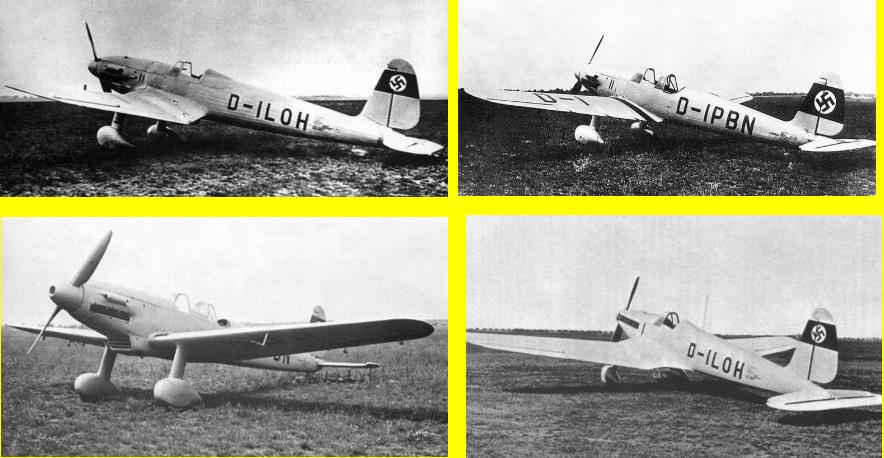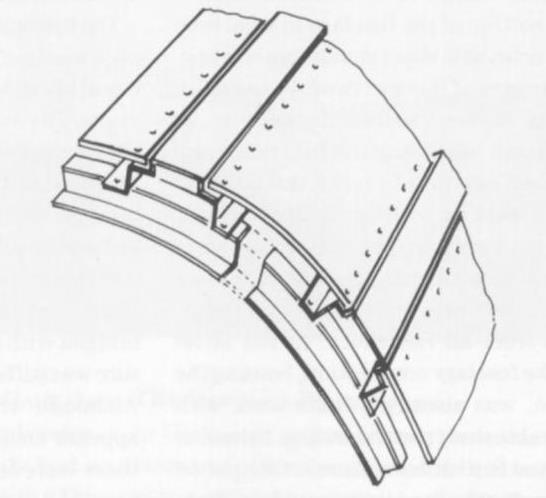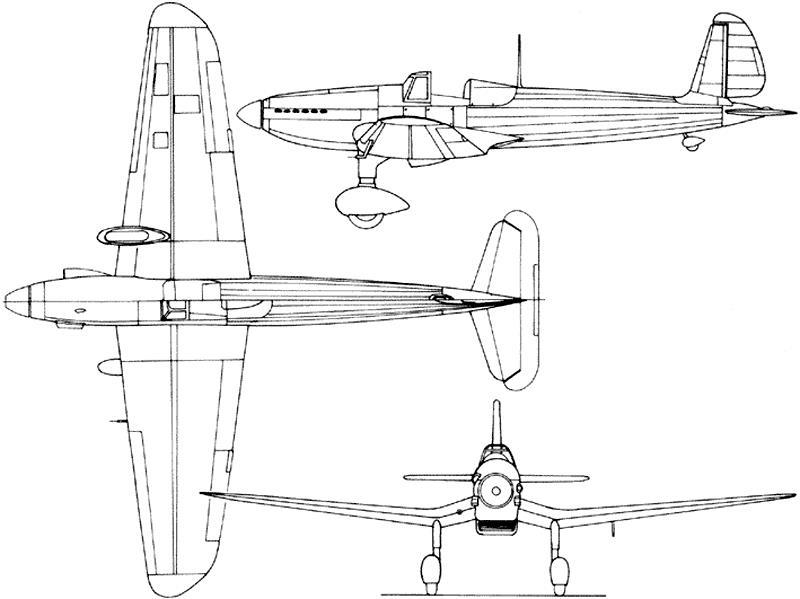William Green : Warplanes of the Third Reich
Although Blume was officially the director of design at Arado, it was Rethel who did most of the early work on the design. Rethel was well aware of the advantages and disadvantages of the monocoque technique, but the company had never built such a design and was thus at a distinct disadvantage in relation to Heinkel who had used it on their He 70 Blitz design from 1932.
However he felt that he could not only design a successful monocoque aircraft, but in fact make one that was both lighter and easier to build than the techniques being used at other companies. His solution was to use two sets of skinning plates formed in long strips running front to back along the plane.
The first set of plates was formed roughly into the shape of a C, which a small flange at the open ends of the C where they could be easily riveted to the hoop bulkheads. Using this system he was able to eliminate one more piece of internal structure, the stringers that would normally run between the bulkheads. He used a second set of sheets that were flat, so they could easily bend front-to-back. They were cut into teardrop shapes, which exactly fit into the gaps between the main stringers. Not only did this system allow for the "perfect" aerodynamic shape, but in theory it was also lighter and easier to build. The system looked so hopeful that other parts of the aircraft's design were allowed to be heavier and less risky as the weight savings in the fuselage should compensate.
The rest of the plane was conventional. The forward fuselage and inner wings were formed up from steel tubing with removable aluminium sheeting over it, the outer wings were aluminium formers and skinned with aluminium on top and fabric on the bottom. Like the Heinkel designs, the wing included a reverse-gull bend to shorten the landing gear legs, but unlike the Heinkel it was almost straight on the leading and trailing edges instead of the more complex elliptical planform favoured by the Günter brothers.
In order to avoid cutting the outer wing formers with outward retracting gear, Rether decided to have the landing gear retract directly to the rear. To lie flat, the wheel would have to be rotated through 90° as it retracted, with its mainwheel resting atop the lower end of the strut as with the contemporary American Curtiss P-36 Hawk fighter design. To do this, Rethel placed the main oleo strut inside a larger tube that was mounted to the pivot point on the lower leading edge of the box-spar. As the gear retracted a small arm would pull on a lever mounted to the oleo, turning the leg inside the larger tube.
In general terms, the resulting design was very similar to the Hawker Hurricane of roughly the same era.
The design, now known as the Ar 80, was completed without the aid of Rethel; he left the company in 1934 to join BFW leaving Blume in charge of the project.
The plane was designed to mount the Jumo 210 engine, driving a wooden two-blade fixed-pitch propeller. However, this engine was not going to be ready until the contest was supposed to be over, so all of the contestants looked for other engines to fill the hole. In this case Arado proved to have the advantage, as they had already purchased a 391 kW (525 hp) Rolls-Royce Kestrel VI engine for use on their Ar 67 design. The engine had less than optimal supercharging which led to poor performance for the Ar 67.
The V1 prototype first took to the air in the spring of 1935, one of the first of the planes in the contest to do so. However, one of the company test pilots lost control during testing spin maneuvres only weeks later, and V1 was written off.
The landing gear had already proven to be a real problem in these few short weeks. It continued to stick half-closed when retracted, although luckily it returned to the down position for landing. Repeated attempts to find the problem were fruitless, when they put the plane on blocks in the hangar it would always work flawlessly. Eventually, it was found that the air pressure on the front of the strut in flight made the oleo jam in its tube so it couldn't rotate.
Another problem discovered during construction of the V1 was that Rethel's monocoque technique in fact turned out to be much heavier than expected. Some of this was a problem in the actual design; since the sheets ran the length of the plane, they had to be as thick as the thickest point on the entire plane. More traditional designs could use lighter or heavier gauges in various places. The main problem, however, was that the design required considerably more rivets than expected, and as a result the plane was overweight.
V2 was rushed to completion but the Jumo was still unavailable. In order to give the contestants some sort of realistic engine, the RLM had traded Rolls-Royce an He 70 for four 518 kW (695 hp) Kestrel V engines. Although the V was the same basic engine as the VI, it had much better supercharging and was in fact the most powerful inline engine of the day. The various companies competed heavily for access to these engines for their prototypes. Perhaps some idea of the future outcome can be seen in the fact that BFW received two, Arado and Heinkel one each, and Focke-Wulf none at all.
V2 was completed with the Kestrel by autumn of 1937, and started company testing. Once again, the gear proved to be a problem. Blume immediately blamed all of the problems on Rethel, after noting that he was always skeptical of the design. He decided that the performance problems of having fixed gear would be offset by its lighter weight, and the Ar 80 then reverted to using a well-spatted and faired set of gear similar to those used on their various biplane designs. Several months were lost in the conversion.
The use of the fixed gear didn't save as much weight as expected and the plane was still 16% over the design weight at 1,630 kg (3,590 lb) empty. Fully loaded the plane was 2,100 kg (4,630 lb) even without armament, which made it underpowered even with the Kestrel V. Drag was also higher than expected. Thus, the plane proved to have very disappointing performance, reaching only 410 km/h (255 mph).
In early 1936, the Jumo engines finally arrived. The 210 had even less takeoff power than the Kestrel, but its altitude performance was comparable. Speed did increase with this engine at higher altitudes, but low-level speed and climb performance both dropped. Arado argued that the fitting of a constant speed propeller would boost both, with the speed climbing to 425 km/h (264 mph), but this was not attempted before the plane was sent off to the contest.
Although the Ar 80 had been one of the first planes to fly, the continued problems with the gear and engine supply meant it was one of the last to arrive for the head-to-head fly-off. It was delivered to Travëmunde on 8 February 1936, and later moved to meet the rest of the planes at Rechlin-Lärz Airfield in March. It was clear all along that the plane had no chance against the Heinkel and BFW designs, a fact that Arado was made officially aware of after only one month.
By this point, V3 was already finished. In order to try to save weight, the design had removed the gull-wing and replaced it with a "flat" one, requiring slightly longer gear legs. It also mounted the Jumo 210C with the constant-speed propeller, which boosted speed to 410 km/h (255 mph). By this time, the RLM had already given up on the design, so the plane was not sent for testing and instead hangared at the Arado plant.
In 1937, the V3 was resurrected as a flying testbed for several experiments. It was fitted with a second seat behind the pilot for an observer, and also added an enclosed canopy. The plane was first used for testing a 20 mm cannon firing through the spinner, making it the first German cannon-armed fighter.
In 1938, the V3 was rebuilt once again, this time to test a new Fowler Flap design Arado was intending to use on their Ar 198 and Ar 240. Testing showed that the flap was so effective that the lift distribution along the wing changed radically, so a further modification was added to "droop" the ailerons along with the flaps. Testing continued for some time in this form, resulting in the "Arado traveling aileron" and "Arado landing flap".
| Type |
V1 Single seat fighter |
V2 Single seat fighter |
V3 Single seat fighter |
| Engine |
1 Rolls-Royce Kestrel VI |
1 Rolls-Royce Kestrel V |
1 Junkers Jumo 210C |
| Dimensions |
Length 10,30 m, height 2,65 m, span 10,89 m, wing area 21,0 m2 |
|
Length 10,10 m, height 2,75 m, span 11,80 m, wing area 21,0 m2 |
| Weights |
Empty , loaded , max. take off weight |
Empty weight 1642 kg, flying weight 2125 kg |
Empty weight 1645 kg, flying weight 2100 kg |
| Performance |
Max.. speed , cruising speed , range , endurance , service ceiling , climb |
Max. speed 415 km/h at 2700 m, range 800 km, rate of climb 9,5 m/sec. ???? |
Max. speed 435 km/h ?? |
| Armament |
2 7.92mm MG 17 machine guns (proposed) |
| Type |
Werk.Nr |
Registration |
History |
| V1 |
861 |
D-ILOH ? |
First flight 26 July 1935. Ready for testing in July 1935, crashed soon when testing spin at Brandenburg, the pilot Schröder was saved by the parachute |
| V2 |
862 |
D-IMEM ? |
First flight in octber 1935. Oct. 1935 with a Rolls-Royce Kestrel engine, probably from the V1. Later a Junkers Jumo 210C was used. Got an enclosed cockpit.(as D-IMEM) |
| V3 |
863 |
D-IROK ?
|
First flight in July 1937. Dec. 1935, had a Jumo 210C with a variable pitch propeller. Tested Fowler flaps and different cannon arangement firing through the prop.hub. Rebuilt with a straight wing (as D-IPBN |
| V4 |
|
D-INEI, D-ILNI ??? |
Got a Jumo 210 (as D-ILNI), Probably rebuilt V2 orV3 |
| V5 |
1297 |
D-IPBN ? |
Two seater. Used in 1940 for testing a safety device to restrict all rudders during high speed |



